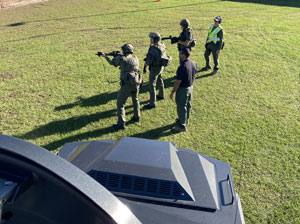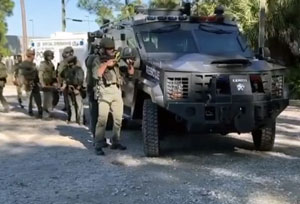 George Creamer worked for a large metropolitan sheriff’s department in the Southern California area for almost 32 years, over 15 years with the SWAT Team. Rich Diliberti has spent the last 29 years working for a large metropolitan sheriff’s department in the Southern California area , 15 years working for the SWAT team and about 3 years ago moved to the tactical medical portion of the SWAT team unit. Rich is now a full-time tactical paramedic for the SWAT team with a secondary responsibility of doing helicopter rescue operations in the very rural parts of the Angeles National Forest and other areas within the county that are inaccessible by ground. George and Rich are co-owners of Integrated Tactical Concepts providing training to SWAT operators around the county and around the world.
George Creamer worked for a large metropolitan sheriff’s department in the Southern California area for almost 32 years, over 15 years with the SWAT Team. Rich Diliberti has spent the last 29 years working for a large metropolitan sheriff’s department in the Southern California area , 15 years working for the SWAT team and about 3 years ago moved to the tactical medical portion of the SWAT team unit. Rich is now a full-time tactical paramedic for the SWAT team with a secondary responsibility of doing helicopter rescue operations in the very rural parts of the Angeles National Forest and other areas within the county that are inaccessible by ground. George and Rich are co-owners of Integrated Tactical Concepts providing training to SWAT operators around the county and around the world.
What is SWAT
SWAT was developed for critical incidents that were above and beyond the capabilities of your peace officer. It came about to where this selected group of people were specially trained and had access to different pieces of equipment that regular patrol didn’t have, such as certain technologies, certain weapon systems, chemical agents, armored vehicles, incidents of that nature that you don’t normally see out there with patrol. Local, state, and federal law enforcement utilize SWAT teams.
The most common situation that a SWAT team would be activated for are going to be high risk warrant service. These are basically pre-planned operations that require certain types of equipment, certain types of training, a certain level of expertise because the criminals that you’re going after are meeting a certain threshold of violence, history of violence, or a propensity for violence. It rises to a threshold where a conventional warrant service team such as a detective bureau or a narcotics bureau would not be comfortable handling it, so it gets passed up to a SWAT team. Being on a SWAT team is one of the most challenging jobs in law enforcement as well as one of the most important positions in a police department.
The next most common situation that SWAT Teams are called out for are suspects that are barricaded inside of a residence, a vehicle, or a business. These are suspects that have for whatever reason fled from the police, or have avoided arrest and information has led the police to a particular location where the suspect is confirmed to be there. But when he’s given the opportunity to surrender, he doesn’t take that opportunity and he decides to basically shelter himself in the house and refuses to surrender, but the crime that he committed does not allow the police department to just walk away. Police are basically responsible for staying there until the suspect is apprehended, and the crime reaches a certain level, A level of crime when it becomes a SWAT team responsibility. That’s probably the second most common event that a SWAT team is called out to do.
The third and probably least frequent, but one of the most challenging events a SWAT team is called to do is hostage rescue. Hostage rescue is anyone who has barricaded themselves in a car, a residence, or a business, but they’re not alone. They’ve got other people in there with them that they are using as leverage to either avoid being arrested, or to try to facilitate a way to escape. They might be using them as a bargaining chip, threatening violence against them. Those are probably and very fortunately the least frequent event that SWAT teams go to, but they’re by far the most challenging and the most dangerous things SWAT teams respond to.
What is the Makeup of a SWAT Team
 The general makeup of a SWAT team varies by city and by population. It can go any anywhere from a 7-person team all the way up to a 50-plus person team. The teams that George and Rich are familiar with would have a scout of the team and that person is responsible for the day-to-day activity of the SWAT team and for the tactics that are going to be used. For either a pre-planned warrant service or any tactical issue that comes up, the scout is responsible. There is a backup scout who assists the scout in all of the day-to-day operations of running a team.
The general makeup of a SWAT team varies by city and by population. It can go any anywhere from a 7-person team all the way up to a 50-plus person team. The teams that George and Rich are familiar with would have a scout of the team and that person is responsible for the day-to-day activity of the SWAT team and for the tactics that are going to be used. For either a pre-planned warrant service or any tactical issue that comes up, the scout is responsible. There is a backup scout who assists the scout in all of the day-to-day operations of running a team.
There is a “fourth man” who is responsible for intelligence gathering and that is an extremely important position on the SWAT team. If you have the fourth man for a hostage rescue, that individual, that fourth man, is so important to get out information because all hostage rescues are driven by intelligence. The team needs to know the guy’s mindset. They need to know how many people are inside. They need to know the ages of the people inside. The team needs to know if the suspect has military experience; If he lost his job, if he’s on drugs, all that information. It is vital to have somebody in that fourth man position that’s extremely experienced and on their game to where they can get that proper information out to the scout and backups during critical incidents. Then there are the fifth and our sixth, and those are equipment people. Those are the people that will supply equipment to the team that is out there. They’ll supply chemical agents, they’ll supply technology. One person may come up with armored vehicles. Someone may bring and handle drones. There is a supervisor which is a sergeant.
How SWAT Teams Train
The things that a SWAT team is required to train for are several. The list is very, very long, but there are shooting skills and the skill of being able to move as a team. There are several different disciplines with technology, breaching equipment, less than lethal equipment, all the trucks that need to be driven, all the different weapon systems, and so forth. All of that required constantly having to be trained over and over again because all of those skills are perishable.
Scenario Based Training
If SWAT members not a forward-thinking, smart tacticians, the tools they have don’t really do you a whole lot of good. Therefore, in addition to all the fundamentals that SWAT teams train on, they do a lot of scenario-based exercises where they put people in positions to have to make critical decisions, so that when they do it for real, those decisions will be able to come to them much faster and much clearer. That’s basically how a SWAT team for the most part conduct their training.
Full-Time SWAT Teams
 The SWAT team that George worked with and the Rich still works with are full-time teams, so they are able to train constantly, where most other teams in the country are part-time teams. Meaning, that they have a full-time job with their department outside of their SWAT team, and their SWAT team is a collateral function. Because of that, their training time is much more limited. They might get a couple of days per month to try to squeeze in all of their training. George and Rich found over their years of working for the sheriff’s department SWAT team is these agencies would constantly be coming to them in order to help provide as much training as they could in the limited amount of time that the requesting team had. These agencies unfortunately were at the mercy of George’s and Rich’s schedule, which because they were with one of the busiest SWAT teams in the country, they were not available a lot of the time, and they were consistently having to reschedule or turn people away because operations would come up. This is where the idea of forming a training company outside of the sheriff’s department started.
The SWAT team that George worked with and the Rich still works with are full-time teams, so they are able to train constantly, where most other teams in the country are part-time teams. Meaning, that they have a full-time job with their department outside of their SWAT team, and their SWAT team is a collateral function. Because of that, their training time is much more limited. They might get a couple of days per month to try to squeeze in all of their training. George and Rich found over their years of working for the sheriff’s department SWAT team is these agencies would constantly be coming to them in order to help provide as much training as they could in the limited amount of time that the requesting team had. These agencies unfortunately were at the mercy of George’s and Rich’s schedule, which because they were with one of the busiest SWAT teams in the country, they were not available a lot of the time, and they were consistently having to reschedule or turn people away because operations would come up. This is where the idea of forming a training company outside of the sheriff’s department started.
Creating a SWAT Training Company
By creating a company, Integrated Tactical Concepts, that would provide training to SWAT Teams, George and Rich would be able to provide training for these agencies separate from the limitations of the schedule that the sheriff’s department SWAT team had. George had all of these “SWAT guys” at his disposal within his department, so he decided to create a training company. When Integrated Tactical Concepts provides training, they don’t just cover the how, they are also covering “why” they do it a particular way.
Hostage Rescue Situations
Within a team of eight or 50 or more, not everybody can be an “A” player on those teams. It’s not going to happen. There are levels of expertise no matter what, and every single person on that team that is going to be dealing with a hostage rescue has got to know what their limitations are. George has seen it where he had expectations of certain people that did not pan out when bullets were flying, and that’s just the reality of it. Then he has experienced where he assumed expectations of certain people, and it was way off the charts when the bullets were flying. Meaning, he never would have thought that person responded the way that they did in such a professional manner and so forth.
The Important of the Intelligence
When a SWAT Team is dealing with a hostage rescue, it is vital get the information as to what is actually happening so that they know what you are dealing with.
- Do they have a guy that went into a liquor store and was robbing the place and on his way out, a policeman was pulling up to get a soda, and now all of a sudden he doesn’t want to go to jail, so he’s inside with the clerk?
- Do they have the dad down the street that lost his job four months ago, has three kids to provide for, has been on medication and drinks alcohol excessively, and has found out that his wife is having an affair, and now those kids and that wife are in the house?
 Those are two completely different scenarios that fall under the umbrella of a hostage rescue. With both of those scenarios the person inside that is the threat is not allowing these people to leave, they’re being held. However, those are two completely different scenarios, and they have to be treated differently. A hostage rescue cannot be rubber stamped. The main goal in a hostage rescue is for everyone to be safe and to get the hostages out safely. They don’t want anyone to get hurt. They don’t want bad guys to get hurt. They clearly don’t want the innocents to get hurt and with that being said, that is exactly what SWAT teams train for.
Those are two completely different scenarios that fall under the umbrella of a hostage rescue. With both of those scenarios the person inside that is the threat is not allowing these people to leave, they’re being held. However, those are two completely different scenarios, and they have to be treated differently. A hostage rescue cannot be rubber stamped. The main goal in a hostage rescue is for everyone to be safe and to get the hostages out safely. They don’t want anyone to get hurt. They don’t want bad guys to get hurt. They clearly don’t want the innocents to get hurt and with that being said, that is exactly what SWAT teams train for.
The Four Priorities of Life in a Hostage Rescue
- The number one priority in a hostage rescue are the hostages.
- Secondly are going to be the innocent people and civilians that might be involved, but aren’t quite hostages. People on the street, neighbors.
- The number three level is law enforcement.
- The forth level is the “bad guy.”
The number one is what you want to build your tactics around. If it does come down to a crisis where the SWAT team actually has to enter a structure or a car or something like that, it is vital to get to those hostages before they get injured. If the suspect gets in the way of doing that, which does happen, then that individual will be dealt with in the level in which that person has risen to. If a team can get in and can get the hostages out without having to deal with the suspect, then that’s a victory. A SWAT team can always deal with somebody in the house by themselves. They can take their time on that, however, there may be factors affecting the duration. Weather or climate may be a factor. A SWAT operator in southern California where it never gets below a certain degree has a lot more time. Some guy in Wisconsin that’s a SWAT operator dealing with 20 below zero temperatures has to build their tactics around that.
Related Links

 Joseph Libowsky,
Joseph Libowsky,